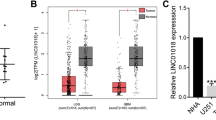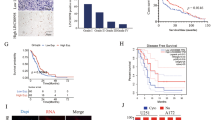Abstract
Long non-coding RNAs (lncRNAs) LINC00152 plays important roles in the progression of some tumors. However, the role of LINC00152 in human l glioblastoma is still unknown. In this study, we indicated that LINC00152 expression level was upregulated in glioblastoma tissues and cell lines. Overexpression of LINC00152 promoted the U87 and LN229 cell proliferation and invasion. Moreover, overexpression of LINC00152 suppressed the E-cadherin expression, where ectopic expression of LINC00152 promoted the N-cadherin, Vimentin, and Snail expression. These results suggested that LINC00152 enhanced epithelial-to-mesenchymal transition (EMT) program in the glioblastoma cell. Overexpression of LINC00152 suppressed the miR-107 expression in the U87 cell and enhanced the HMGA2 expression, which is a direct target gene of miR-107. In addition, we showed that the miR-107 expression was downregulated in the glioblastoma tissues and cell lines. Interesting, the expression of LINC00152 was negatively related with miR-107 expression in the glioblastoma tissues. Furthermore, LINC00152 promoted the glioblastoma cell proliferation and invasion through inhibiting miR-107 expression. These data suggested that LINC00152 acted as oncogene roles in the glioblastoma cell partly through targeting the miR-107 expression.






Similar content being viewed by others
Change history
10 April 2024
Editor's Note: Readers are alerted that the concerns have been raised with this article. Editorial action will be taken as appropriate once this matter is resolved and all parties have been given an opportunity to respond in full.
References
Agrawal R, Pandey P, Jha P, Dwivedi V, Sarkar C, Kulshreshtha R (2014) Hypoxic signature of microRNAs in glioblastoma: insights from small RNA deep sequencing. BMC Genomics 15:686
Cai Q, Wang ZQ, Wang SH, Li C, Zhu ZG, Quan ZW, Zhang WJ (2016) Upregulation of long non-coding RNA LINC00152 by SP1 contributes to gallbladder cancer cell growth and tumor metastasis via PI3K/AKT pathway. Am J Transl Res 8:4068–4081
Chen WM, Huang MD, Sun DP, Kong R, Xu TP, Xia R, Zhang EB, Shu YQ (2016) Long intergenic non-coding RNA 00152 promotes tumor cell cycle progression by binding to EZH2 and repressing p15 and p21 in gastric cancer. Oncotarget 7:9773–9787
Costa PM, Cardoso AL, Nobrega C, Pereira de Almeida LF, Bruce JN, Canoll P, Pedroso de Lima MC (2013) MicroRNA-21 silencing enhances the cytotoxic effect of the antiangiogenic drug sunitinib in glioblastoma. Hum Mol Genet 22:904–918
He X, Tan X, Wang X, Jin H, Liu L, Ma L, Yu H, Fan Z (2014) C-Myc-activated long noncoding RNA CCAT1 promotes colon cancer cell proliferation and invasion. Tumour Biol 35:12181–12188
Hermansen SK, Kristensen BW (2013) MicroRNA biomarkers in glioblastoma. J Neuro-Oncol 114:13–23
Hiddingh L, Raktoe RS, Jeuken J, Hulleman E, Noske DP, Kaspers GJ, Vandertop WP, Wesseling P, Wurdinger T (2014) Identification of temozolomide resistance factors in glioblastoma via integrative miRNA/mRNA regulatory network analysis. Sci Rep 4:5260
Huang Z, Huang L, Shen S, Li J, Lu H, Mo W, Dang Y, Luo D, Chen G, Feng Z (2015) Sp1 cooperates with Sp3 to upregulate MALAT1 expression in human hepatocellular carcinoma. Oncol Rep 34:2403–2412
Kim J, Zhang Y, Skalski M, Hayes J, Kefas B, Schiff D, Purow B, Parsons S, Lawler S, Abounader R (2014) microRNA-148a is a prognostic oncomiR that targets MIG6 and BIM to regulate EGFR and apoptosis in glioblastoma. Cancer Res 74:1541–1553
Kitagawa M, Kotake Y, Ohhata T (2012) Long non-coding RNAs involved in cancer development and cell fate determination. Curr Drug Targets 13:1616–1621
Lai NS, Wu DG, Fang XG, Lin YC, Chen SS, Li ZB, Xu SS (2015) Serum microRNA-210 as a potential noninvasive biomarker for the diagnosis and prognosis of glioma. Br J Cancer 112(Suppl):1241–1246
Li C, Lei BX, Huang SB, Zheng MG, Liu ZH, Li ZJ, Deng YF (2015a) H19 derived microRNA-675 regulates cell proliferation and migration through CDK6 in glioma. Am J Transl Res 7:1747–1764
Li J, Wang XC, Tang JW, Jiang RQ, Zhang WJ, Ji J, Sun BC (2015b) HULC and LINC00152 act as novel biomarkers in predicting diagnosis of hepatocellular carcinoma. Cell Physiol Biochem 37:687–696
Li JQ, Hu SY, Wang ZY, Lin J, Jian S, Dong YC, Wu XF, Dai L, Cao LJ (2016a) Long non-coding RNA MEG3 inhibits microRNA-125a-5p expression and induces immune imbalance of Treg/Th17 in immune thrombocytopenic purpura. Biomed Pharmacother 83:905–911
Li Z, Shen JX, Chan MTV, Wu WKK (2016b) TUG1: a pivotal oncogenic long non-coding RNA of human cancers. Cell Prolif 49:471–475
Lin L, Gu ZT, Chen WH, Cao KJ (2015) Increased expression of the long non-coding RNA ANRIL promotes lung cancer cell metastasis and correlates with poor prognosis. Diagn Pathol 10:14
Liu J, Wan L, Lu K, Sun M, Pan X, Zhang P, Lu B, Liu G, Wang Z (2015) The long noncoding RNA MEG3 contributes to cisplatin resistance of human lung adenocarcinoma. PLoS One 10:e0114586
Lu H, He Y, Lin L, Qi Z, Ma L, Li L, Su Y (2015) Long non-coding RNA MALAT1 modulates radiosensitivity of HR-HPV+ cervical cancer via sponging miR-145. Tumour Biol 37:1683–1691
Luo Y, Sun R, Zhang J, Sun T, Liu X, Yang B (2015) miR-506 inhibits the proliferation and invasion by targeting IGF2BP1 in glioblastoma. Am J Transl Res 7:2007–2014
Ma MZ, Chu BF, Zhang Y, Weng MZ, Qin YY, Gong W, Quan ZW (2015) Long non-coding RNA CCAT1 promotes gallbladder cancer development via negative modulation of miRNA-218-5p. Cell Death Dis 6:e1583
Neumann O, Kesselmeier M, Geffers R, Pellegrino R, Radlwimmer B, Hoffmann K, Ehemann V, Schemmer P, Schirmacher P, Bermejo JL, Longerich T (2012) Methylome analysis and integrative profiling of human HCCs identify novel protumorigenic factors. Hepatology 56:1817–1827
Nie FQ, Sun M, Yang JS, Xie M, Xu TP, Xia R, Liu YW, Liu XH, Zhang EB, Lu KH, Shu YQ (2015) Long noncoding RNA ANRIL promotes non-small cell lung cancer cell proliferation and inhibits apoptosis by silencing KLF2 and P21 expression. Mol Cancer Ther 14:268–277
Qu S, Yao Y, Shang C, Xue Y, Ma J, Li Z, Liu Y (2012) MicroRNA-330 is an oncogenic factor in glioblastoma cells by regulating SH3GL2 gene. PLoS One 7:e46010
Rao SA, Arimappamagan A, Pandey P, Santosh V, Hegde AS, Chandramouli BA, Somasundaram K (2013) miR-219-5p inhibits receptor tyrosine kinase pathway by targeting EGFR in glioblastoma. PLoS One 8:e63164
Sana J, Radova L, Lakomy R, Kren L, Fadrus P, Smrcka M, Besse A, Nekvindova J, Hermanova M, Jancalek R, Svoboda M, Hajduch M, Slampa P, Vyzula R, Slaby O (2014) Risk score based on microRNA expression signature is independent prognostic classifier of glioblastoma patients. Carcinogenesis 35:2756–2762
Wang Y, Chen FQ, Zhao M, Yang Z, Zhang SQ, Ye LH, Gao HW, Zhang XD (2016) MiR-107 suppresses proliferation of hepatoma cells through targeting HMGA2 mRNA 3’ UTR. Biochem Biophys Res Commun 480:455–460
Wei X, Chen D, Lv T, Li G, Qu S (2014) Serum MicroRNA-125b as a potential biomarker for glioma diagnosis. Mol Neurobiol 53:163–170
Wu Y, Tan C, Weng WW, Deng Y, Zhang QY, Yang XQ, Gan HL, Wang T, Zhang PP, Xu MD, Wang YQ, Wang CF (2016) Long non-coding RNA Linc00152 is a positive prognostic factor for and demonstrates malignant biological behavior in clear cell renal cell carcinoma. Am J Cancer Res 6:285–299
Xiao H, Tang K, Liu P, Chen K, Hu J, Zeng J, Xiao W, Yu G, Yao W, Zhou H, Li H, Pan Y, Li A, Ye Z, Wang J, Xu H, Huang Q (2015) LncRNA MALAT1 functions as a competing endogenous RNA to regulate ZEB2 expression by sponging miR-200s in clear cell kidney carcinoma. Oncotarget 6:38005–38015
Xin Y, Li Z, Shen JX, Chan MTV, Wu WKK (2016) CCAT1: a pivotal oncogenic long non-coding RNA in human cancers. Cell Prolif 49:255–260
Yang T, Zeng HM, Chen WQ, Zheng RS, Zhang Y, Li ZX, Qi J, Wang MJ, Chen TH, Lou JL, Lu LG, Zhou T, Dai SY, Cai M, You WC, Pan KF (2016) Helicobacter pylori infection, H19 and LINC00152 expression in serum and risk of gastric cancer in a Chinese population. Cancer Epidemiol 44:147–153
Yu FB, Li GH, Gao JX, Sun YX, Liu PF, Gao HJ, Li PW, Lei T, Chen Y, Cheng Y, Zhai X, Sayari AJ, Huang HY, Mu QC (2016) SPOCK1 is upregulated in recurrent glioblastoma and contributes to metastasis and Temozolomide resistance. Cell Prolif 49:195–206
Yue B, Cai DL, Liu CC, Fang CY, Yan DW (2016) Linc00152 functions as a competing endogenous RNA to confer oxaliplatin resistance and holds prognostic values in colon cancer. Mol Ther 24:2064–2077
Zhang EB, Kong R, Yin DD, You LH, Sun M, Han L, Xu TP, Xia R, Yang JS, De W, Chen J (2014a) Long noncoding RNA ANRIL indicates a poor prognosis of gastric cancer and promotes tumor growth by epigenetically silencing of miR-99a/miR-449a. Oncotarget 5:2276–2292
Zhang W, Zhang J, Hoadley K, Kushwaha D, Ramakrishnan V, Li S, Kang C, You Y, Jiang C, Song SW, Jiang T, Chen CC (2012) miR-181d: a predictive glioblastoma biomarker that downregulates MGMT expression. Neuro-Oncology 14:712–719
Zhang Y, Ma M, Liu W, Ding W, Yu H (2014b) Enhanced expression of long noncoding RNA CARLo-5 is associated with the development of gastric cancer. Int J Clin Exp Pathol 7:8471–8479
Zhang YH, Fu J, Zhang ZJ, Ge CC, Yi Y (2016) LncRNA-LINC00152 down-regulated by miR-376c-3p restricts viability and promotes apoptosis of colorectal cancer cells. Am J Transl Res 8:5286–5297
Zhao W, Dong S, Duan BS, Chen P, Shi L, Gao HJ, Qi HZ (2015) HOTAIR is a predictive and prognostic biomarker for patients with advanced gastric adenocarcinoma receiving fluorouracil and platinum combination chemotherapy. Am J Transl Res 7:1295–1302
Zhu H, Zhou X, Chang H, Li H, Liu F, Ma C, Lu J (2015) CCAT1 promotes hepatocellular carcinoma cell proliferation and invasion. Int J Clin Exp Pathol 8:5427–5434
Author information
Authors and Affiliations
Corresponding author
Additional information
Responsible editor: Philippe Garrigues
Rights and permissions
About this article
Cite this article
Liu, X., Yidayitula, Y., Zhao, H. et al. LncRNA LINC00152 promoted glioblastoma progression through targeting the miR-107 expression. Environ Sci Pollut Res 25, 17674–17681 (2018). https://doi.org/10.1007/s11356-018-1784-x
Received:
Accepted:
Published:
Issue Date:
DOI: https://doi.org/10.1007/s11356-018-1784-x




